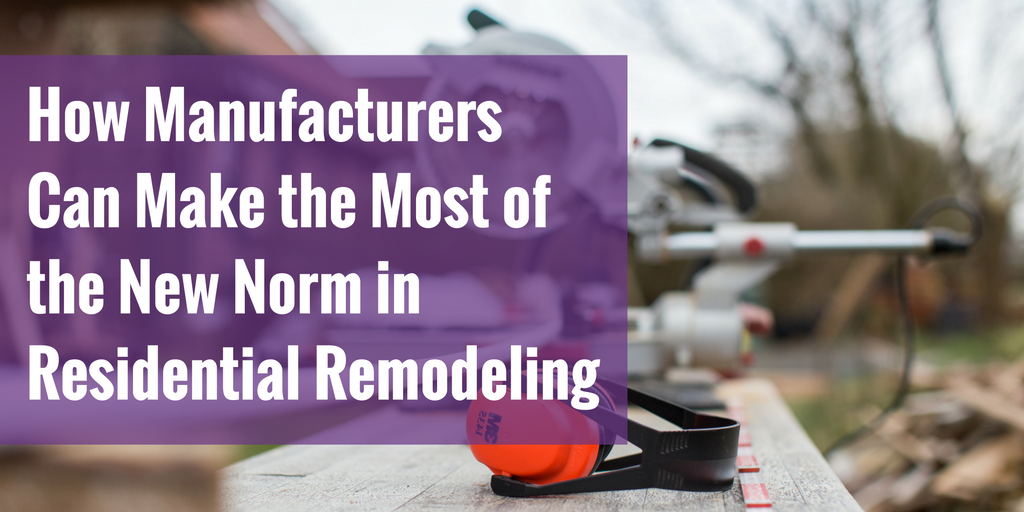
We recently compared residential new construction and residential remodeling permit activity over the lifecycle of the recent housing crisis.
We found that residential remodeling activity has surpassed its pre-housing crisis peaks while new construction has barely kept up.
“Given that we are looking at more than a decade of data,” said Holly Tachovsky, CEO at BuildFax, “the strong residential remodeling numbers as compared to the new construction numbers may be the new norm.”
This trend has enormous implications for anyone involved in construction. And for building product manufacturers, it cannot be ignored.
The Study: Remodeling Vs. New Construction
To draw this conclusion, we looked at residential additions, remodels, and alterations (ARAs), and new construction permit activity from 2005 through 2016. The trending lines told two very different stories.

Residential remodeling took a much smaller dip after the housing market downturn when compared with new home construction permits. At its trough, residential ARAs took just a 30.9% dip compared to their pre-housing crisis numbers.

But the decline in new residential construction permits pulled was profoundly steeper. It went through the floor during the crisis. There was a staggering 69.8% decrease between August 2005 and August of 2009.

Boiled down
- New residential construction permits plummeted by 69.8% between 2005 and 2009. Today, they’re still 56.4% below pre-crisis peaks – having only recovered by 26%.
- Residential remodeling on the other hand, took only a 30.9% hit between 2005 and 2009. Residential remodeling has gained ground by 4.1% when compared to pre-crisis peaks – recovering an astonishing 104%.
If you assume that residential remodeling trends along with new construction activity, you’ll see a bleaker outlook than if you looked at them separately. This would undoubtedly influence, and possibly hinder, strategic decision-making.
But if you look at the residential remodeling trend line, you’ll see this pattern shows no signs of slowing. This pace presents a sector of construction activity that is ripe with opportunities for growth. So what does that opportunity look like?
Here are four distinct areas where this new market trend of high residential remodel rates can impact a building product manufacturers’ business.
1. Opportunities for Strategic Insight
Whether you’re forecasting annual business volume, transaction numbers, revenue, or growth rate, these remodeling numbers are something to pay close attention to.
These are the key areas where companies are maximizing the upward trend in residential remodeling activity.
- Facilities planning
- Better forecasting
- Deeper understanding of regional market share
2. Sales Strategies
Given that residential new construction and remodeling are currently going along two very different trajectories, it’s more important than ever to note the differences, especially as they relate to sales and marketing strategies.
“When we talk to sales leaders in the market,” said Jonathan Kanarek, COO at BuildFax, “they tell us that being able to accurately identify which areas of the market are in growth or decline makes a big difference in how they sell and market their products – Everything from where they’re putting their staff to how they’re distributing quota.”
3. Targeted Outreach to Top Contractors
Marketing in the residential remodeling space is ripe with opportunity too. Identifying top remodeling contractors in the remodeling space is essential in deciding who and where to target. Remodeling firms are predicting a 17% increase in revenue in 2016. And since the upward remodeling trend doesn’t appear to be going anywhere anytime soon, targeting the who’s who in the remodeling space is a no brainer.
4. Product Development
Given the new norm of high residential remodeling rates, should specialty products be developed to meet the demands and tastes of remodelers, especially in regards to older home renovations? Further, are there ways to improve products so they’re easier to implement in an existing structure?
“Think about spray foam insulation,” said Tachovsky, “and how useful it is for a remodel. Roll out insulation is fine for new construction, but not really efficient during a renovation when walls may not be exposed. The product is well-suited for a remodel. Just think of the endless possibilities for improving other products and applications tailored for remodeling.”
To summarize:
- The upward trend in residential remodeling appears to be the new norm, and companies are capitalizing on this growth with opportunities for strategic insight including facilities planning, market share perspective, improved forecasting, and more
- Sales and marketing should pay attention to the areas of the market that are in growth or decline because it can sharpen sales strategies and help target the best marketing leads
- This new norm in accelerated residential remodeling activity presents unique opportunities to develop products specially suited to remodeling
For more information on how building permit data can benefit your company’s strategy, contact us today.